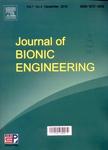Solid Desiccant Dehumidification Techniques Inspired from Natural Electroosmosis Phenomena
Solid Desiccant Dehumidification Techniques Inspired from Natural Electroosmosis Phenomena作者机构:Faculty of Engineering University of Nottingham Lenton Firs Building University Park Nottingham NG7 2RD UK
出 版 物:《Journal of Bionic Engineering》 (仿生工程学报(英文版))
年 卷 期:2011年第8卷第1期
页 面:90-97页
核心收录:
学科分类:081704[工学-应用化学] 07[理学] 08[工学] 0817[工学-化学工程与技术] 070302[理学-分析化学] 0805[工学-材料科学与工程(可授工学、理学学位)] 080502[工学-材料学] 0703[理学-化学]
基 金:国家自然科学基金
主 题:biomimetics electroosmotic flow solid desiccant dehumidification
摘 要:Electroosmosis has been shown to be an effective means of different applications in various fields such as Micro-Electro-Mechanical systems (MEMS) and biomimetics applications. This paper aims to prove the concept that the electroosmosis phenomena can also be cooperated into larger scale applications in the building service industry like dehumidification or damping proof. The electroosmotic flow inside a porous medium is validated experimentally to further understand the dehumidification mechanism of combined techniques. An experimental test validates that the condensation from the porous medium can be obtained by electroosmotic force generated by external electric field, especially for specific desiccant powders like zeolite and diatomaceous earth. With a range of volts from 5 V to 20 V applying between the testing plates, the maximum flow rate through the cross section in the testing plate achieved during the peak period is 1.35 laL'min 1. These promising phenomena can act as an alternative way for energy choice in dehumidification industrial field. Further researches on new regeneration methods for solid desiccant dehumidification are required to make the system simple, energy-saving and suitable for small air conditioning units.



